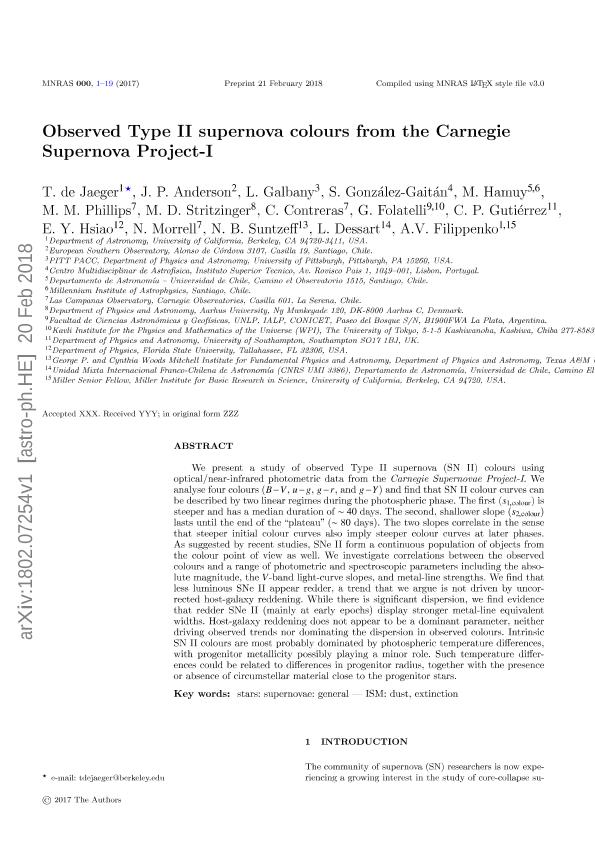Mostrar el registro sencillo del ítem
dc.contributor.author
de Jaeger, T.
dc.contributor.author
Anderson, J. P.
dc.contributor.author
Galbany, L.
dc.contributor.author
González Gaitán, S.
dc.contributor.author
Hamuy, M.
dc.contributor.author
Phillips, M. M.
dc.contributor.author
Stritzinger, M. D.
dc.contributor.author
Contreras, C.
dc.contributor.author
Folatelli, Gaston

dc.contributor.author
Gutiérrez, C. P.
dc.contributor.author
Hsiao, E. Y.
dc.contributor.author
Morrell, Nidia Irene

dc.contributor.author
Suntzeff, N. B.
dc.contributor.author
Dessart, L.
dc.contributor.author
Filippenko, A. V.
dc.date.available
2019-08-29T14:19:57Z
dc.date.issued
2018-06
dc.identifier.citation
de Jaeger, T.; Anderson, J. P.; Galbany, L.; González Gaitán, S.; Hamuy, M.; et al.; Observed Type II supernova colours from the Carnegie Supernova Project-I; Oxford University Press; Monthly Notices of the Royal Astronomical Society; 476; 4; 6-2018; 4592-4616
dc.identifier.issn
0035-8711
dc.identifier.uri
http://hdl.handle.net/11336/82472
dc.description.abstract
We present a study of observed Type II supernova (SN II) colours using optical/near-infrared photometric data from the Carnegie Supernovae Project-I. We analyse four colours (B - V, u - g, g - r, and g - Y) and find that SN II colour curves can be described by two linear regimes during the photospheric phase. The first (s, 1colour) is steeper and has a median duration of ~40 d. The second, shallower slope (s, 2colour) lasts until the end of the 'plateau' (~80 d). The two slopes correlate in the sense that steeper initial colour curves also imply steeper colour curves at later phases. As suggested by recent studies, SNe II form a continuous population of objects from the colour point of view as well. We investigate correlations between the observed colours and a range of photometric and spectroscopic parameters including the absolute magnitude, the V-band light-curve slopes, and metal-line strengths. We find that less luminous SNe II appear redder, a trend that we argue is not driven by uncorrected hostgalaxy reddening. While there is significant dispersion, we find evidence that redder SNe II (mainly at early epochs) display stronger metal-line equivalent widths. Host-galaxy reddening does not appear to be a dominant parameter, neither driving observed trends nor dominating the dispersion in observed colours. Intrinsic SN II colours are most probably dominated by photospheric temperature differences, with progenitor metallicity possibly playing a minor role. Such temperature differences could be related to differences in progenitor radius, together with the presence or absence of circumstellar material close to the progenitor stars.
dc.format
application/pdf
dc.language.iso
eng
dc.publisher
Oxford University Press

dc.rights
info:eu-repo/semantics/openAccess
dc.rights.uri
https://creativecommons.org/licenses/by-nc-sa/2.5/ar/
dc.subject
Dust
dc.subject
Extinction
dc.subject
Supernovae: General
dc.subject.classification
Astronomía

dc.subject.classification
Ciencias Físicas

dc.subject.classification
CIENCIAS NATURALES Y EXACTAS

dc.title
Observed Type II supernova colours from the Carnegie Supernova Project-I
dc.type
info:eu-repo/semantics/article
dc.type
info:ar-repo/semantics/artículo
dc.type
info:eu-repo/semantics/publishedVersion
dc.date.updated
2019-08-23T17:43:46Z
dc.journal.volume
476
dc.journal.number
4
dc.journal.pagination
4592-4616
dc.journal.pais
Reino Unido

dc.journal.ciudad
Oxford
dc.conicet.avisoEditorial
This article has been accepted for publication in Monthly Notices of the Royal Astronomical Society © 2017 The Authors Published by Oxford University Press on behalf of the Royal Astronomical Society. All rights reserved.
dc.description.fil
Fil: de Jaeger, T.. University of California at Berkeley; Estados Unidos
dc.description.fil
Fil: Anderson, J. P.. European Southern Observatory Santiago; Chile
dc.description.fil
Fil: Galbany, L.. University of Pittsburgh at Johnstown; Estados Unidos. University of Pittsburgh; Estados Unidos
dc.description.fil
Fil: González Gaitán, S.. Instituto Superior Tecnico; Portugal
dc.description.fil
Fil: Hamuy, M.. Universidad de Chile; Chile. Millennium Institute Of Astrophysics; China
dc.description.fil
Fil: Phillips, M. M.. Las Campanas Observatory; Chile
dc.description.fil
Fil: Stritzinger, M. D.. University Aarhus; Dinamarca
dc.description.fil
Fil: Contreras, C.. Las Campanas Observatory; Chile
dc.description.fil
Fil: Folatelli, Gaston. University Of Tokyo; . Consejo Nacional de Investigaciones Científicas y Técnicas. Centro Científico Tecnológico Conicet - La Plata. Instituto de Astrofísica La Plata. Universidad Nacional de La Plata. Facultad de Ciencias Astronómicas y Geofísicas. Instituto de Astrofísica La Plata; Argentina
dc.description.fil
Fil: Gutiérrez, C. P.. University of Southampton; Reino Unido
dc.description.fil
Fil: Hsiao, E. Y.. Florida State University; Estados Unidos
dc.description.fil
Fil: Morrell, Nidia Irene. Las Campanas Observatory; Chile
dc.description.fil
Fil: Suntzeff, N. B.. Texas A&M University; Estados Unidos
dc.description.fil
Fil: Dessart, L.. Universidad de Chile; Chile
dc.description.fil
Fil: Filippenko, A. V.. University of California at Berkeley; Estados Unidos
dc.journal.title
Monthly Notices of the Royal Astronomical Society

dc.relation.alternativeid
info:eu-repo/semantics/altIdentifier/doi/http://dx.doi.org/10.1093/mnras/sty508
dc.relation.alternativeid
info:eu-repo/semantics/altIdentifier/url/https://academic.oup.com/mnras/article-abstract/476/4/4592/4907983
Archivos asociados
